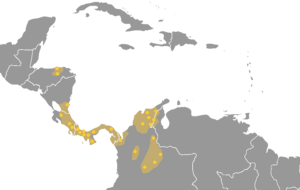Chibchan languages facts for kids
Quick facts for kids Chibchan |
|
|---|---|
| Geographic distribution: |
Costa Rica, Panama and Colombia |
| Linguistic classification: | Macro-Chibchan ?
|
| Subdivisions: |
—
|
| ISO 639-5: | cba |
 |
|
The Chibchan languages are a group of languages spoken by native people in parts of Central and South America. These languages are found in an area stretching from eastern Honduras to northern Colombia. This includes countries like Nicaragua, Costa Rica, and Panama.
The name "Chibchan" comes from an extinct language called Chibcha or Muisca. This language was once spoken by people living near Bogotá, the capital of Colombia. However, experts now think that the Chibchan languages might have actually started closer to the border between Costa Rica and Panama. This area has the most different types of Chibchan languages.
Contents
What are Chibchan Languages?
Chibchan languages are a family of languages. This means they are all related and come from a common ancestor language. Think of it like a family tree for languages! These languages are spoken by different groups of indigenous people.
How Chibchan Languages are Related to Others
Some experts believe that Chibchan languages might be part of an even bigger language family called Macro-Chibchan. This larger group could also include languages like Misumalpan languages, Xinca, and Lenca. This idea was supported by a linguist named Kaufman in 1990. More recently, Pache (2018, 2023) has suggested a possible link to the Macro-Jê languages, based on how their grammar works.
Languages Influencing Each Other
Languages often borrow words or ideas from each other, especially if people who speak different languages live close by. This is called "language contact." Jolkesky (2016) found that Chibchan languages share some words with other language families. This is likely because they were in contact with groups speaking Andaki, Barbakoa, Choko, Duho, Paez, Sape, and Taruma languages.
Chibchan Language Family Tree
Here's a look at how the Chibchan languages are grouped. Some of these languages are still spoken today, while others are sadly extinct.
- Chibchan
- A
- Waimí (Guaymi)
- Guaymí (Ngäbere, Movere) – About 170,000 people speak this. It's vulnerable in Panama and endangered in Costa Rica.
- Buglere (Bokotá) – Around 18,000 speakers. It is endangered.
- Borũca (Brunca) – Only about 140 speakers. It is nearly extinct.
- Talamanca
- Huetar (Güetar) †
- Bribri (Talamanca) – About 7,000 speakers. It's vulnerable in Costa Rica and endangered in Panama.
- Cabécar (Talamanca) – Around 8,800 speakers. It is vulnerable.
- Teribe (Norteño) – About 3,300 speakers. It is endangered.
- Waimí (Guaymi)
- B
- Pech (Paya) – Around 990 speakers. It is endangered.
- Dorasque †
- Votic
- Rama – About 740 speakers. It is nearly extinct.
- Voto †
- Maléku (Guatuso) – Around 750 speakers. It is endangered.
- Corobicí – Spoken in northwestern Costa Rica. †
- Cuna–Colombian
- A
* Barí (Motilón) – Around 5,000 speakers. It is vulnerable. * Chibcha–Tunebo ** Muisca – † ** Duit † ** U'wa (Tunebo) – About 2,550 speakers. It is endangered. ** Guane † – From Colombia.
-
-
-
- Arwako–Chimila
-
-
* Chimila – Around 350 speakers. It is endangered. * Arwako ** Wiwa (Malayo, Guamaca) – About 1,850 speakers. It is endangered. ** Kankuamo † ** Arhuaco (Ikʉ) – Around 8,000 speakers. It is vulnerable. ** Kogi (Cogui) – About 9,910 speakers. It is vulnerable.
Some other languages, like Old Catío and Nutabe from Antioquia, have also been shown to be Chibchan. The language of the Tairona people is not well known, but it might be one of the Arwako languages. The Zenú (also known as Sinú) language from northern Colombia is sometimes included, but there isn't much proof.
A linguist named Adolfo Constenla Umaña thought that Cueva, an extinct language from Panama, was actually related to Chocoan languages, not Chibchan. However, there's not much evidence to support this idea. The Cofán language (Kofán) from Ecuador and Colombia was mistakenly thought to be Chibchan because it borrowed some words.
Pache (2023) suggests that Pech is most closely related to the Arhuacic languages of northern Colombia. They form a smaller group together.
Many Varieties of Chibchan Languages
Over time, many different types of Chibchan languages have existed. Some are still spoken today, while others have become extinct. Linguists like Loukotka (1968) have listed many of these varieties, even those that are no longer spoken.
For example, the Rama language is spoken in Nicaragua. The Guatuso language was spoken in Costa Rica, but it might be extinct now. In the Talamanca group, languages like Bribri and Cabecar are still spoken in Costa Rica. The Cuna language is spoken in Panama. Many languages from the Antioquia and Chibcha groups in Colombia, like Muisca, are now extinct.
The Original Chibchan Language
Linguists study how languages change over time. They try to reconstruct what the very first version of a language family, called a "proto-language," might have sounded like. For Chibchan languages, this means trying to figure out what "Proto-Chibchan" was like.
Pache (2018) has done the most recent work on reconstructing Proto-Chibchan. Another important reconstruction was done by Holt (1986). These reconstructions help us understand the history of these languages and how they are all connected.

